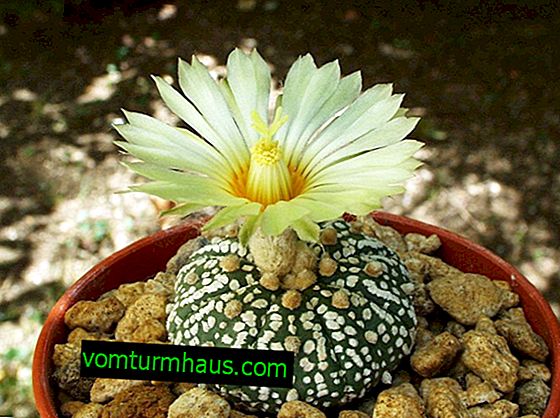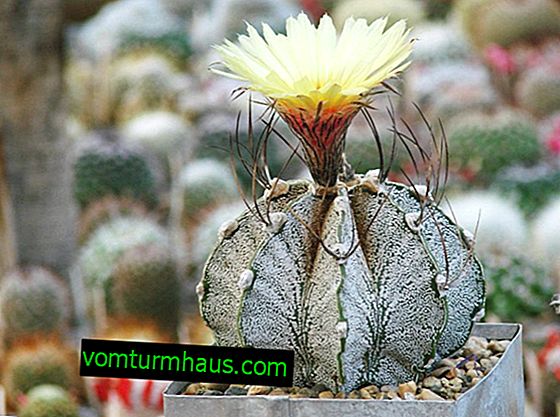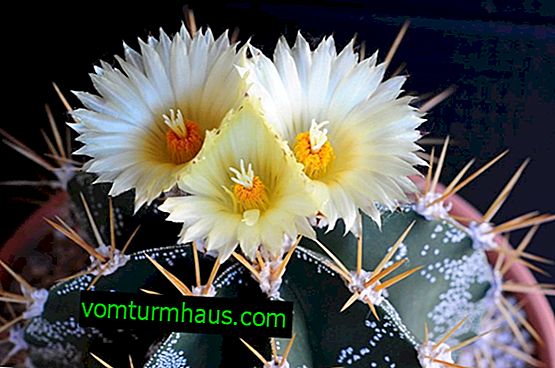Astrophytum: home care
Cactus astrophytum, or, as it is also called, stellate cactus, is a genus of succulents from the Cactus family, representatives of which have a spherical or cylindrical stem. They grow wild in Mexico and Texas, but they are also often kept as home ornamental plants. It is about the content of astrophytum at home that will be discussed in our article.
Botanical description of the plant
All representatives of the genus Astrophytum from other cacti are distinguished by a spherical stem, sometimes elongated, with pronounced ribs. Due to this feature, the plant looks like a polygonal star. The stem can be covered with long curved or straight thorns, and can be completely bare. Its color is also original: a lot of bright spots covering the surface of the plant and forming unusual patterns.

| Root system | Spindle-shaped |
| Stem | Spherical, with edges, green, gray-green or speckled |
| Flower shape | Funnel-shaped |
| Flower color | Yellow, yellow red |
| Fruit shape | Oval, ripened - asterisk |
| Fruit color | Green |




















The main types
The classification of astrophytum into species is ambiguous: each of them has its own varieties, which are often distinguished as an independent species. But most often adhere to this separation:
- Astrophytum is stellate, or asterias. This representative has no thorns and in its shape it resembles a sea urchin. It has a spherical shape (d ̴̴ 15 cm), is painted in gray-green color and consists of 6–8 edges. On the center line of each rib there are round fleecy areoles of whitish-gray color. It grows quite slowly. The flowers are yellow with a red middle, with a diameter of about 7 centimeters. This species does not like direct sunlight.

- Astrophytum Capricorn, or Capriccone. The young plant has a round stem, which gradually lengthens over time, becoming cylindrical. It can stretch up to 25 centimeters, while its diameter is about 15 centimeters. Eight ribs divide the stem covered with curved long spines. The main tone is dark green, specks are light. They may be completely absent. Blooms in bright yellow. The core of the flowers is red. In this form, three varieties are distinguished: V. Craccipinum (the flower has no red core), V. minus (the stem is smaller), astrophytum V. niveum (white, with bizarrely curved thorns).

- Speckled, or multi-stalked. The most popular and unpretentious representative of his species with a bald dark green stalk dotted with many felt small specks. The shape of the stem can be round, flattened, elongated. The number of edges also varies depending on the shape, but usually their number is five. The flowers are bright yellow, can be with a red-orange core. Diameter - about 6 centimeters.

- Astrophytum decorated. The highest among all species. It grows pretty fast. It has a high spherical stalk of dark green color with eight ribs. Its diameter can be about 10–20 centimeters with a height of about 30 centimeters. In its natural habitat, the plant can grow up to 200 cm in height. Small specks on the stem are grouped into stripes and form interesting patterns. At home, not everyone can see the flowering of this cactus, but in nature only old plants are able to decorate themselves with flowers. The flowers are pale yellow, up to 10 cm in diameter.

Conditions for successful growing at home
The birthplace of the flower is hot and sunny countries, respectively, at home for it is necessary to recreate similar climatic conditions.
Did you know? Speckled astrophytum was opened in 1837, and from that moment it began to be massively imported into European lands. Only a dozen years later, it was established that the appearance depends on the place where the astrophytum grows: then all the representatives of the plant were divided into varieties.
Location
Cactus loves sunlight very much, but not direct, but diffused. Because of this, it is best to place in the southern part of the house. It can be accustomed to direct sunlight, but this must be done gradually. From the beginning of spring it must be shaded until it gets used to direct light.

Temperature
In the hot season, the cactus grows well at a temperature of about 28 ° C. But due to the fact that in his homeland the temperature can drop significantly at night, at home the flower needs the same temperature jumps. Because of this, in the summer it is better to keep it on the balcony or loggia. In winter, the comfortable temperature is at least 10 ° C. Good ventilation is also needed.
Important! If you leave the astrophytum on the street, then take care of protecting the plant from rain. Excess moisture is useless to him.
Air humidity
Cacti came to us from countries where rainfall is extremely rare and the temperature is always high. Therefore, they will feel great in the dry microclimate of urban housing. Damp air will only cause fungal diseases.
Home Care
Astrophytum, like all cacti, is an absolutely unpretentious plant. The main thing is to choose the right soil for him, occasionally water and feed him.

Watering
Intensive watering of the flower is absolutely not needed. In hot time, it is irrigated only when the substrate dries well over its entire thickness. In the autumn they moisturize once a month, and in winter they do not irrigate at all. Watering is carried out through a pallet, since locking the root system is extremely harmful to the flower. Water should be filtered or settled, since lime can clog pores in the stem, thereby disrupting the gas exchange of the plant. Water is preferably used at room temperature. The optimal watering time is the morning hours.
Did you know? Astrophytums were discovered in 1827. The first sight discovered was a decorated Astrophytum.
Top dressing
From spring to autumn, astrophytum is fed once a month. For these purposes, a special fertilizer for cacti is used - it is bred in water. The dosage is taken two times less than that prescribed on the packaging with top dressing.
Transfer
A flower is transplanted only when the pot has become small for it (it is completely filled with roots). The new capacity is selected a little larger. As the soil, a substrate for cacti is used.
The sequence of actions is as follows:
Recommended Reading

- Pick a suitable pot with large drainage holes.
- Pour drainage (expanded clay).
- Remove the plant from the old pot without brushing the roots off the ground. Place in a new one on top of the drainage layer.
- Sprinkle it with a special substrate with the addition of a small amount of lime or activated carbon powder. The ground level should not overlap the neck of the cactus. It is advisable to leave it in its original place.
- Lay decorative stones on top of the ground. This will protect the plant’s neck from contact with moist soil.
- Watering the transplanted plant takes place in a week. This is necessary so that the roots, if they are damaged, have time to recover.
Seed cultivation
Astrophytum reproduces exclusively by seed. They are harvested during the fruiting period and, if necessary, stored for one to two years. Sowing is best done in mid-February - early March. The step-by-step process looks like this:
- Soak the collected seeds for seven minutes in a light pink solution of potassium permanganate.
- At this time, prepare the substrate: mix in equal proportions sheet soil, charcoal, river sand.
- Fill the container with a diameter of 10 cm and a depth of 3–7 cm with a substrate. Pour it.
- Spread dried seeds evenly over the surface of the earth without sprinkling them.
- Cover the pot with a film and place in a humid sunny place with a temperature of 25-30 ° C. Once a day, the pot is ventilated and, if necessary, watered from the spray gun. The first shoots may appear in a few days.
- After 2-3 weeks, the shoots dive (between shoots a distance of 2-3 mm is left). Next, you need to dive when the plants again approach each other.
- When the cactus reaches a diameter of 1.5–2 cm, it is transplanted into its own pot.
Video: growing Astrophytum from seeds
Growing difficulties
All the difficulties of growing astrophytum are associated with the attack of a plant by various pests and diseases.
Important! It is possible to transplant astrophytum in winter, since during this period the plant is at rest.
Pests
The main enemy of the flower is the scale shield . The plant is covered with sticky spots or brown dots. They must be removed with a thin sharp object (toothpick, needle). If you can’t remove it, then you need to water the plant with a solution of actara or confidor. A week later should be repeated.



Disease
The most common astrophytum disease is rot. It occurs due to soil jamming and high humidity. If the process of decay has begun, then stopping it is extremely difficult. The flower withers before our eyes, turning into a wrinkled bump. If the rot touched only a small portion of the stem, then it can be cut and sprinkled with a powder of coal. This will allow the plant to survive, but with the loss of its beauty.
In addition to diseases and pests, cactus breeders may encounter such problems:
- The base of the flower begins to rot, and the crown shrinks - waterlogged the soil.
- The stalk is very long - poor lighting, warm winter.
- Very slow growth - high temperature in summer, poor watering during this period, or excess moisture in winter.
- The stalk is covered with brown spots - poor watering, the use of water containing lime.








